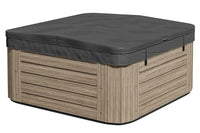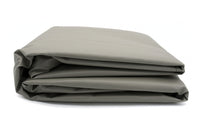How long does it take a hot tub to heat up? If you asked a Midwesterner outdoors in the middle of winter, they might tell you, “An eternity.” However, there are more concrete and data-based ways of answering the question!
In this article, The Cover Guy explores a comprehensive guide to understanding heating times for your backyard spa. We look at the numerous factors impacting timing, like the ambient temperature, water volume, and spa cover usage. We look at general estimates for common hot tub scenarios—standard times as well as special circumstances. Then, let's tackle one of the most common search queries surrounding the topic: How do you speed up your sluggish heat times?
Hopefully, in answering these burning questions, The Cover Guy can help improve your user experience and efficiency to a) get you in the tub quicker, b) save a little money on utilities, and c) ensure your investment runs as it should.
Start your timers, and let’s hit the spa.
Normal Factors That Affect Hot Tub Heating Time
Unfortunately, there’s no single factor influencing heat times for hot tubs. Reasons for slow heating can vary from spa to spa. Often, the underlying causes point to a confluence of normal issues. As is often the case with determining hot tub issues, your first role is to play detective.
Read through the following factors to determine which one(s) might apply to your backyard tub. If none of these apply, skip to the section below about troubleshooting to determine whether something wrong is happening.
- Ambient Temperature: Obviously, the outdoor temperature surrounding the tub will affect its heating time. Just think about trying to heat your car in the dead of winter versus an unseasonably warm fall day—the former takes a lot longer. Excessively low outdoor temperatures extend your hot tub heating time, while warm and hot ambient temperatures may expedite the process.
- Water Volume: Imagine heating a full 40-quart pasta pot versus a standard 16-quart pot. That 40-quart behemoth will take a lot longer to reach a bare simmer. The same principle applies to home spas, with more voluminous models needing longer to reach the desired temperature. (That said, larger models often feature more powerful heaters).
- Hot Tub Cover Usage: Running with the pasta pot metaphor, there’s a world of difference between heating that pot with a beaten-up, ill-fitting lid, and heating it with a tight-fitting lid. That said, are you using your custom-made, insulated hot tub covers when you heat up the tub? The Cover Guy’s robustly built covers, made with marine-grade vinyl, double-stitching and powerful heat-sealed foam, will lock in the heat for a faster temperature climb.
- Heater Power: Spas vary according to their heater power, with heaters running the gamut from around 1.5 kilowatts to 27Kw and even above. Typically, you see higher-wattage heaters serving larger tubs, but some smaller tubs come with serious "firepower." Volume definitely plays a role here, too (see above). Larger hot tubs with more water take longer to heat, regardless of heater wattage.
- Water Starting Temperature: Lastly, the initial water temperature will play a role in the tub’s heat time. If you've just filled up your tub with cold water from the backyard hose, it will take appreciably longer to reach your desired temperature than if you started with water you heated just yesterday.
These common factors work together to impact hot tub heating times. And they’re all perfectly normal. In the section below, learn some (rough) expectations for timing in a properly operating tub.
Average Heating Times for Common Hot Tub Scenarios
So, you’ve determined the influence of the factors above. Next, let’s delve into some rough estimates. Obviously, it’s near-impossible to give exact estimates since the above factors vary widely between each spa. Still, it’s helpful to compare your hot tub wait time against these benchmarks; if your wait time is a lot higher, it could indicate an underlying issue that requires action.
Standard Time for an Average Hot Tub
A typical hot tub heats up at a rate of 3-6°F per hour, depending on the heater's power and environmental factors. So, if you're starting from around 50°F, it can take 4 to 8 hours to reach the ideal soaking temperature of 100-104°F. Larger tubs or colder outdoor temperatures may extend this time slightly.
Heating for the First Time
When heating a hot tub for the first time, it may take a bit longer due to cooler water in the pipes and the tub itself. First-time heating can take up to 8-12 hours. Make sure all components are functioning properly to avoid unnecessary delays.
Post-Refill Heating
After refilling your hot tub, the heating time usually resembles that of first-time heating, though it may be slightly faster. Expect it to take around 6-10 hours, depending on how cold the refill water is.
If your tub is taking well over these average benchmarks, it’s time to troubleshoot—see the section directly below.

Troubleshooting: Why Is My Hot Tub Taking So Long to Heat Up?
The factors we’ve discussed so far are normal, everyday characteristics of a hot tub. However, problems can arise that further push back your wait time. These include:
- Heater Problems: Faulty heaters, heaters with insufficient power for your water volume, or heaters past their functional longevity will struggle to heat your spa. If you suspect this is the case, consider contacting a specialist to troubleshoot your damaged hot tub and suggest a replacement heater.
- Dirty Filters and Other Water Circulation Issues: Poor circulation can also affect the heater’s efficiency. Inspect your filters as part of your regular fall and winter hot tub maintenance to determine whether buildup is slowing down circulation. You might also need to replace those filters if they’ve run their course. Lastly, check for air locks in the plumbing, inspect your pumps, and look for blocked jets.
- Imbalanced Water Chemistry: Balanced water chemistry ensures that the pH, alkalinity, and calcium levels are within the recommended range, which helps prevent corrosion or scale buildup on the heater. If the water is too acidic or too alkaline, it can cause damage to the heater’s components, reducing its efficiency and lifespan.
- A Poor Cover: Your cover might be letting precious heat slip away as you bring your spa up to temperature. Consider replacing it with a well-built, custom-made, and suitably insulated cover from our online store.
- Thermostat Issues: Hey, it might not be a problem with your spa. The problem might be a malfunctioning thermostat giving inaccurate readings. Recalibrate your thermostat or consider buying a well-reviewed replacement. The Cover Guy offers a terrific, instant Solar Powered Spa Digital Thermometer (it’s the one we use!).
Understandably, that’s a lot of info to take in, especially for a first-time hot tub owner. Consider the issues above as a checklist of sorts; move down the items as you inspect your spa, and determine if one or several of these issues are causing you grief.
How to Speed Up Your Hot Tub Heating Time
If you’re like us, you’re impatient—at least when it comes to your precious spa time. You want it fast. Here are a few ways to speed up your timing, including making a maintenance checklist, using your cover, and balancing chemicals to clean your hot tub effectively.
- Pre-Warm with the Cover: Using the cover while the hot tub is heating can significantly reduce heat loss. Since most heat escapes from the surface, covering it ensures the heat stays in, speeding up the process by 20-30%.
- Fill with Warmer Water: Starting with warmer water during a refill can save loads of time. If you can fill the hot tub with water around 70-80°F, it can reduce heating time by several hours, since the heater won’t have to work as hard to bring the water to the ideal temperature.
- Optimize Water Circulation: Good water circulation allows the heater to work more efficiently, as the hot water is distributed evenly throughout the tub. To improve circulation, make sure the jets are on during heating and check that filters are clean. Regular filter cleaning or replacement can enhance the water flow, speeding up the overall heating process.
- Balance Your Water Chemistry: As mentioned, imbalanced water chemistry puts a strain on your hot tub heater and other components involved in heating times. If you need help with your balances, refer to other posts in this blog, which tackle dialing in your chemicals for optimal performance.
- Schedule Annual Check-Ups: Annual professional maintenance ensures the heater—and all other relevant components—are working in fine form.
Take these tips one step at a time and see which ones help. As the seasons slowly change, consult our resource on preparing for winter weather to prevent these issues before they become a problem.
To summarize, various factors affect hot tub heating times—some common and innocuous, others revealing deeper issues. Play detective to determine the problem. Then, follow a few easy steps to reduce your wait time, save on utility costs, protect your investment, and sink into relaxation sooner. Bottom of Form










